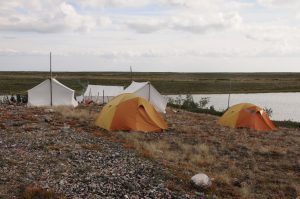Picture this: you’re living in the Northwest Territories in July. It’s officially summer and the sun is shining… But it’s 0 degrees Celsius and your skin instantly shivers upon contact with the air. You’re in the Arctic to collect more information on a beautiful fish species – Lake Trout. At this point, you’re probably wondering: is this research really worth it?

An image showing the living conditions of Arctic researchers in Great Bear Lake.
Let’s look into research at Great Bear Lake (GBL), for instance. It is one of the largest lakes in Canada, covering approximately 31, 000 square kilometers.
What exactly makes the fish in Great Bear Lake so unique?
Well, one example is the wide diversity of Lake Trout that has been observed. These findings are unparalleled in any other ecosystem, which makes GBL very intriguing to scientists all around the world, such as Dr. Louise Chavarie – a fish biologist from Quebec. She has devoted time and effort into exploring complex ecological interactions between fish in the Arctic, which is highlighted in the video below.

A video examining Dr. Chavarie’s data collection methods and the four different Lake Trout body types in GBL.
Surprisingly enough, diversity within a species is shown to increase survivability.
But how are diversity and survivability related?
Imagine a fish species with high variation between body types. The difference in body types may serve as an advantage or a disadvantage, depending on the environmental circumstances. For example, let’s examine a fish species’ vulnerability to predation. Fish with more hydrodynamic body types will be able to escape from incoming predators, giving them an advantage over fish with less hydrodynamic body types. Although not all of the fish population will escape predation, the better adapted ones will live and reproduce, ensuring that the fish stock will not entirely collapse. In the podcast below, Dr. Chavarie emphasizes the importance of Lake Trout diversity, in terms of resilience, when considering upcoming changes to Arctic ecosystems.
So, why should we invest time and resources into Arctic research?
The exceptional findings discovered by Dr. Chavarie and her research team are one example of the many hidden wonders in GBL. You can only imagine all of the beauty masked by the vastness of the Arctic! If we study the Arctic more frequently, we can gain more knowledge on species interactions and further develop our conservation efforts. By doing so, we can continue to rely on fish as a source of employment, revenue and protein!

An image featuring Dr. Chavarie, holding an extremely large Lake Trout fish.
To address our initial question, it is clearly very worthwhile to study Arctic ecosystems. Future research can help us improve our fishing management strategies, which will consequently promote financial and food security for the global population.
SO Group #4: Lexynn Kwan, Steven Li, Armita Payombarnia, Olivia Zhou
